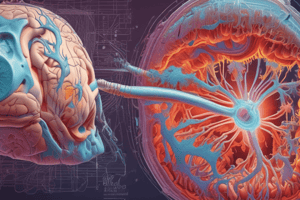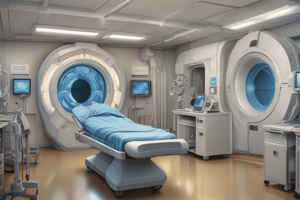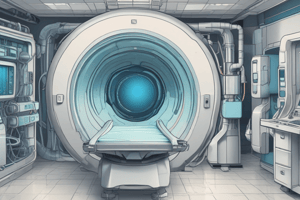Podcast
Questions and Answers
What is the primary factor that causes streaks to appear in CT images?
What is the primary factor that causes streaks to appear in CT images?
- High contrast objects within the scanning area
- Metal implants within the scan range
- Improper selection of reconstruction filters
- Inconsistent data acquisition during the scan (correct)
Which of the following artifact types is characterized by layering effects that appear superimposed on the original image?
Which of the following artifact types is characterized by layering effects that appear superimposed on the original image?
- Bands (correct)
- Shading
- Rings
- Streaks
What is the primary cause of beam hardening artifacts in CT?
What is the primary cause of beam hardening artifacts in CT?
- The use of metal implants in the scan area
- The interaction of x-rays with dense objects (correct)
- Improper alignment of the CT gantry
- Excessive patient movement during the scan
What is the effect of shading artifacts on CT images?
What is the effect of shading artifacts on CT images?
Which of the following is NOT a type of patient-induced CT artifact?
Which of the following is NOT a type of patient-induced CT artifact?
What is the primary cause of edge gradient artifacts in CT images?
What is the primary cause of edge gradient artifacts in CT images?
Which of the following is NOT a solution to minimize beam hardening artifacts in CT?
Which of the following is NOT a solution to minimize beam hardening artifacts in CT?
How are metal artifacts best reduced?
How are metal artifacts best reduced?
Which of these describes beam hardening artifacts?
Which of these describes beam hardening artifacts?
What is one of the effects of partial volume artifacts?
What is one of the effects of partial volume artifacts?
What can help reduce edge gradient artifacts?
What can help reduce edge gradient artifacts?
Which solution is effective for addressing photon starvation artifacts?
Which solution is effective for addressing photon starvation artifacts?
What causes aliasing artifacts during imaging?
What causes aliasing artifacts during imaging?
What is a common result of tube arcing in imaging equipment?
What is a common result of tube arcing in imaging equipment?
What is a solution for addressing artifacts caused by equipment malfunction?
What is a solution for addressing artifacts caused by equipment malfunction?
How can the partial volume effect be minimized during imaging?
How can the partial volume effect be minimized during imaging?
What typically results from incorrect calibration of a detector in a CT scanner?
What typically results from incorrect calibration of a detector in a CT scanner?
Flashcards
Edge gradient artifact
Edge gradient artifact
An artifact caused by abrupt changes in density at object edges in CT imaging.
Motion artifacts
Motion artifacts
Artifacts from patient motion that appear as shading, streaking, blurring, or ghosting in the images.
Beam-hardening artifacts
Beam-hardening artifacts
Artifacts caused by lower-energy photons being absorbed in dense materials, resulting in dark bands or streaks.
Metal artifact
Metal artifact
Signup and view all the flashcards
Out of field artifact
Out of field artifact
Signup and view all the flashcards
Artifact in CT
Artifact in CT
Signup and view all the flashcards
Types of CT Artifacts
Types of CT Artifacts
Signup and view all the flashcards
Streak Artifacts
Streak Artifacts
Signup and view all the flashcards
Beam Hardening
Beam Hardening
Signup and view all the flashcards
Partial Volume Effect
Partial Volume Effect
Signup and view all the flashcards
Aliasing
Aliasing
Signup and view all the flashcards
Photon Starvation: Noise
Photon Starvation: Noise
Signup and view all the flashcards
Ring Artifact
Ring Artifact
Signup and view all the flashcards
Tube Arcing
Tube Arcing
Signup and view all the flashcards
Solutions for Artifacts
Solutions for Artifacts
Signup and view all the flashcards
Study Notes
Artifacts in CT
- Artifacts are anything appearing on a CT image that isn't present in the actual object being scanned.
- They represent a discrepancy between the CT numbers in the image and the expected CT numbers based on the linear attenuation coefficient.
- Artifacts have diverse presentations and causes.
- Sources of artifacts can be broadly categorized as patient-based, equipment-based and physics-based (e.g., radiation).
Learning Outcomes
- Students should be able to define artifacts in CT.
- Students should be able to identify different types of CT artifacts.
- Students should be able to determine appropriate steps to reduce artifacts in CT images.
Appearance of Artifacts
- Streaks: Intense straight lines, either light or dark, enhanced by the reconstruction filter. They stem from inconsistencies in data collection, such as metal or patient movement during scans. They can make images unreadable or unreliable due to false image production during reconstruction.
- Shading: Appear near high contrast objects (e.g., dense objects) within a softer tissue region. This artifact occurs because the CT number in the image shifts, potentially leading to misdiagnosis.
- Bands: Display a layered effect, superimposed on the original images.
- Rings: Circular formations on images, superimposed. These are caused by faulty or miscalibrated detectors.
Patient-Induced Artifacts
- Motion: Results in shading, streaking, blurring, or ghosting artifacts. Voluntary or involuntary motions during the scan cause these artifacts.
- Beam Hardening: Caused by the polychromatic nature of the x-ray beam used in CT. Lower-energy photons are preferentially absorbed, creating a "harder" beam as it passes through objects.
- Metal Artifacts: Create "star streaking" artifacts. Metal objects in the field of view (FOV) absorb photons, causing incomplete profiles and streaking. Removing the objects is the primary solution.
- Out of Field Artifacts: Arises when the patient is not adequately enclosed in the scanning field of view (FOV). Body parts outside the FOV can obstruct detectors and further harden the x-ray beam, causing streaking and shading artifacts.
- Edge Gradient Artifacts: These artifacts are generated when objects with substantial density differences (e.g., barium and air) are adjacent. They are highly visible as streaks, but can be reduced using thinner slices and using a low HU-oral contrast instead of barium/water.
Equipment Artifacts
- Partial Volume Effect: Occurs when an off-center dense object partially protrudes into the x-ray beam path. This appears as shading in some image views. Thinner slice selection and incrementations minimize partial volume artifacts.
- Aliasing: Insufficient data collection due to undersampling (e.g. wrong helical pitch), results in inaccuracies, causing sharp edges and lines to appear incorrectly in the imaging. Increasing scan time, reducing pitch, slowing gantry rotation and use of complete arc scans reduces the risk.
- Photon Starvation (Noise): Occurs in areas with high attenuation (e.g., shoulder). Insufficient photons reach the detectors in these regions, resulting in horizontal streaks. Using higher kVp and mAs and thicker slices helps reduce the risk.
- Ring Artifacts: Caused by malfunctions in the detectors, leading to loss of data in a specific area. Recalibrating the detector or replacing it is typically needed.
- Tube Arcing: Created by tungsten vapor in the x-ray tube impacting the projectile electrons intended for collisions with the target. This causes crackling sounds and potentially produces high-voltage arcing in the tube. Replacing the damaged tube.
- Line in Topogram Artifacts: Continuous lines result from faulty detectors. Replacement of the detector provides resolution.
- Staircase Artifacts: Stem from improper selection of slice thickness and increments. Selecting thinner slices will reduce the staircase effect.
Solutions for Artifacts
- Explain the procedure and communicate effectively with the patient to avoid voluntary motions, use shorter scan times for involuntary motions.
- Use proper filtration or calibration correction software to address beam hardening artifacts.
- Remove external metal objects. Use specific software. Adjust gantry angle.
- Enclose the whole patient into FOV to address out of field artifacts. Use larger FOV, taping technique and patients position adjustments.
- Utilize thinner slices to reduce edge gradient artifacts, use lower HU contrast.
- Using thinner and appropriate slice selections prevents the partial volume effect.
- Increase scan time, reduce pitch, and/or slow gantry rotation to mitigate aliasing.
- Increase kVp or mAs, increase slice thickness to reduce photon starvation artifacts.
- Calibrate or replace the faulty detector to remedy ring artifacts.
- Replace the defective x-ray tube to resolve tube arcing.
- Replace faulty detectors to fix line (in topogram) artifacts and staircase artifacts.
Studying That Suits You
Use AI to generate personalized quizzes and flashcards to suit your learning preferences.




